Pink Inspiration
This week is full of pink art inspiration. I hope that this post will get you to find your pinks and start creating sweetness!
Dreamy Pinks in Colored Pencils
First, one of the journal spreads that we will create at Fun Botanicum, the newest class.
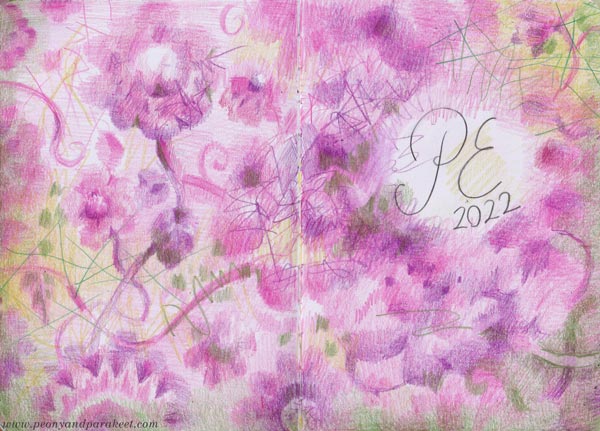
The softness that you can create with colored pencils is divine and you can highlight that with sharp strokes. The versatility of colored pencils always amazes me. With one pencil you can create the whole value range from light to dark so a few pencils go a long way. I like those shelves of individual pencils in art supply stores because it’s like picking candies!
Pink Handdrawn Playing Cards
These cards are from the class Magical Inkdom. They are drawn with a black pen and then colored with watercolors.
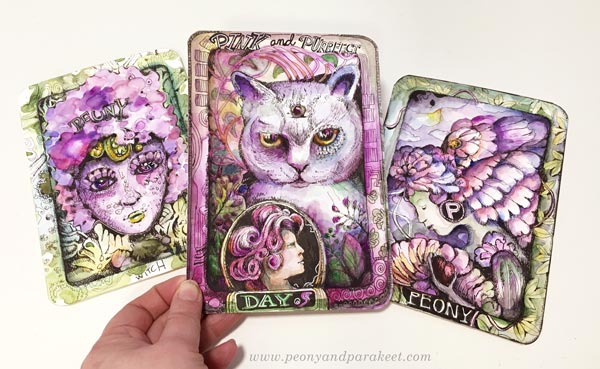
My husband asked when he saw me drawing these:
– “Playing cards? What’s the game?”
– Well, these are like collector’s items! And you can invent the game yourself!
Because if you make more than one, isn’t that like a little oracle deck? You can ask yourself how you feel by picking a card that reflects your mood.
Lots of Pink Petals
I am already waiting for summer and see my pink peonies bloom in June. If I was a small fairy, I could live in those petals!
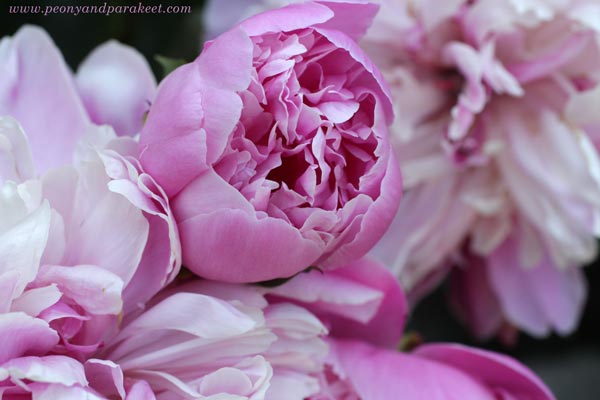
Petals, petals, more pink petals – that’s how the flowers are constructed! These are from the class Decodashery.
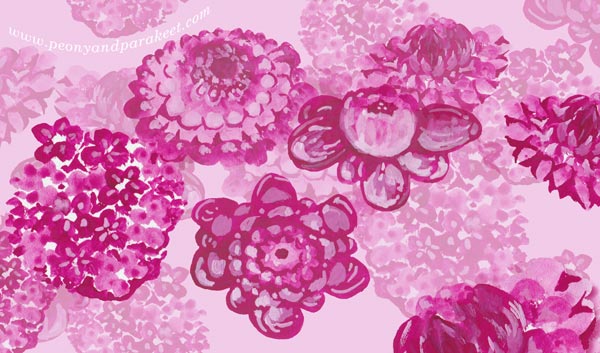
Pick a small brush, some pink gouache paints or watercolors, and paint small spots in layers!
Red and Green are Pink’s Best Pals
Here’s more pink gouache art – a small journal cover that also has reds and greens.
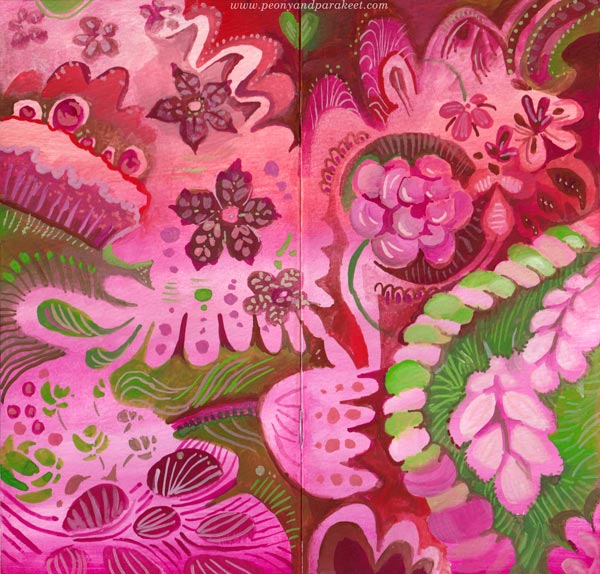
I love this color combination. Each color makes the other shine brighter. I can almost taste the colors when I look at them.
Pink Glow in the Dark
Pink is also a wonderful color with darks. You can paint a pink glow that makes the image look romantic.
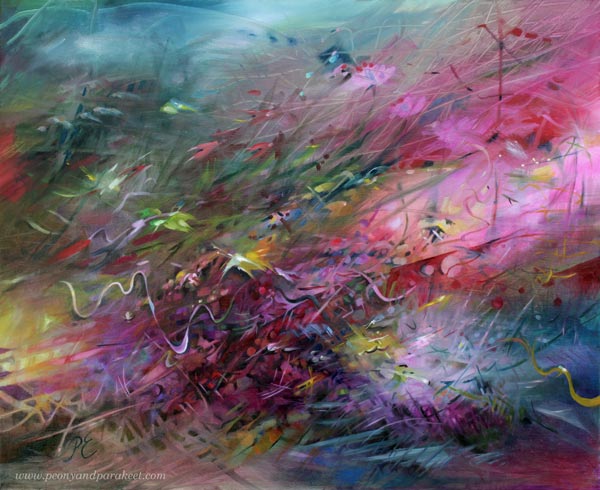
Here’s a blog post where you can see process pictures of this painting.
Powder Pink Inspiration
One night my husband showed me new Swatch watches. I wasn’t so interested at first, but when I saw the photos and got the concept, I got so inspired that I am using that inspiration for the new series of oil paintings!
Here’s the new pink Swatch called Mission to Venus. I am definitely going to somehow incorporate all this into a painting! Not literally, but conceptually.
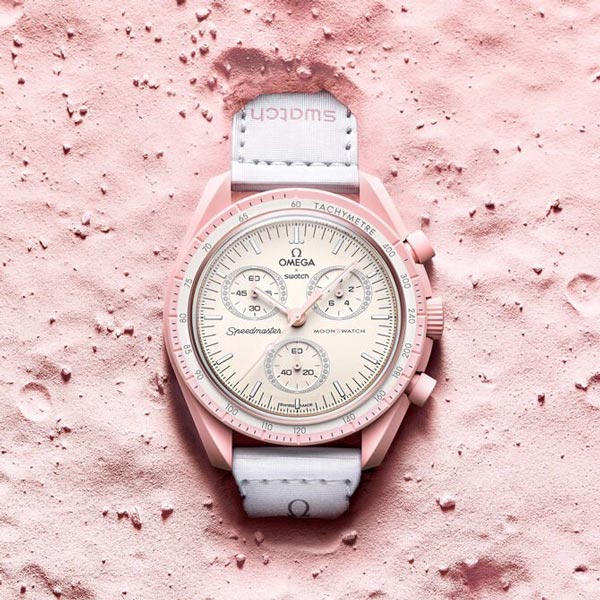
The powder pink with decorative details speaks of a beautiful adventure to me.
This watercolor painting has powder pinks too.
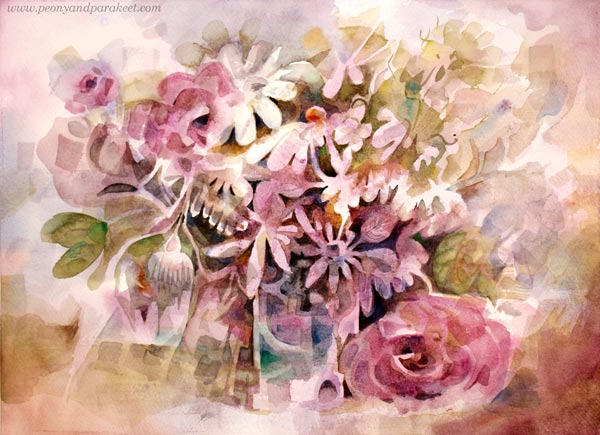
I painted this one a few years ago when my mission was to find the best way to paint flowers freely in watercolors without using a reference. I have a class about it too Floral Fantasies – Watercolor Edition!
Pinks and Other Pastels
What about selecting some acrylic paints and going wild on an art journal?
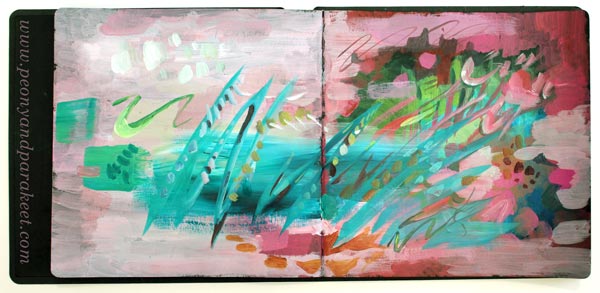
Add darks on the bottom and let dry. Then mix white to the colors and have fun with pastels. Use different brushes to have some variety in strokes as well.
You can be rough like above, or go in a more delicate direction with thinner brushes.
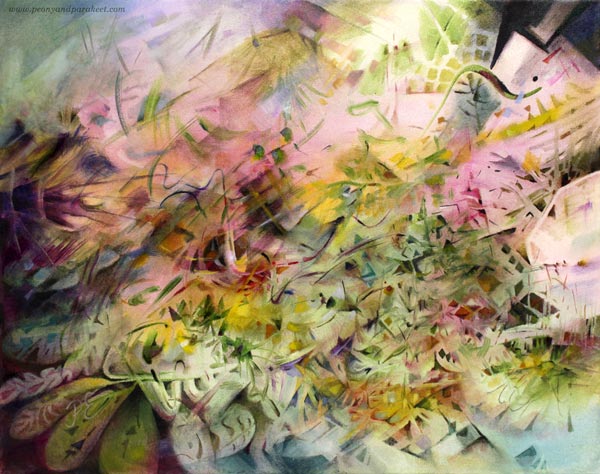
Black with pink is also a great color combination!
Pink Inspiration – How to Go Deeper
If you are a color-oriented artist as I am, pink is never just one pink. Challenge yourself to make all kinds of pinks from light to dark, from warm to cool, and use them all in one painting. Nature doesn’t select just one pink, so why would you?
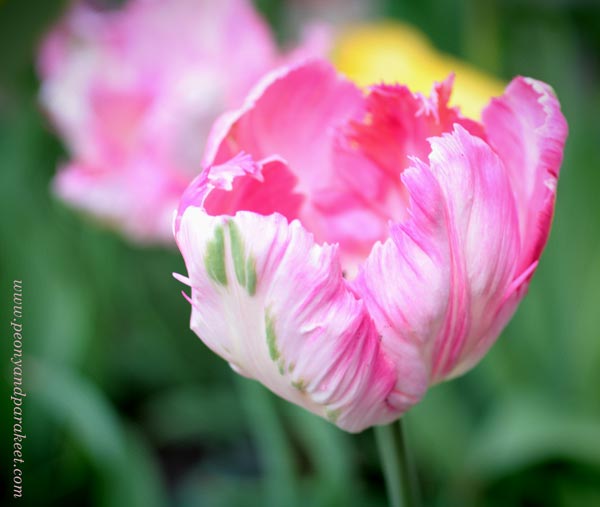
The same goes for shapes, lines, and ideas. The more you embrace the variety, the more exciting the art-making becomes, and the more you create. Restrict supplies and increase imagination!
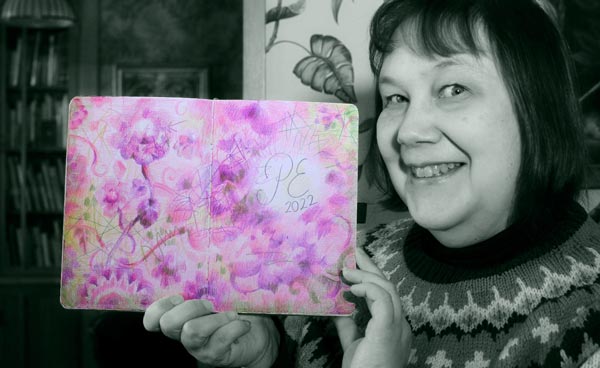
I hope you have an adventurous Pink Inspiration Day!
P.S. You can still sign up for Fun Botanicum and make wonderful colorings of plants!
Green Flowers in Colored Pencils
This week is about embracing green flowers and making your art stand out.
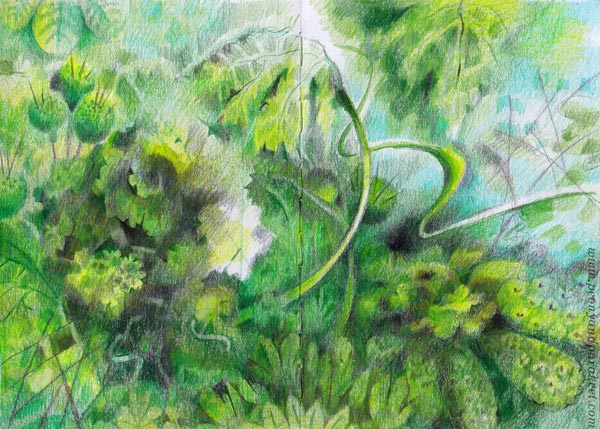
Last month, my husband let me choose flowers for my birthday. I picked green roses that had a hint of pink on their petals. Of course, there were plenty of colors available, but green ones touched my heart. I have always liked old romance novels where the emotions are kept under the surface, and I see a similar kind of suffocation in this bunch.
A rose dreams about becoming pink but sadly realizes that her petals are not much different from her leaves.
I feel a strong bond with green flowers because my art is very similar to their petals, only a slightly improved reflection of the ordinary self. My art goes only as far as I can imagine, and the imagination is often limited.
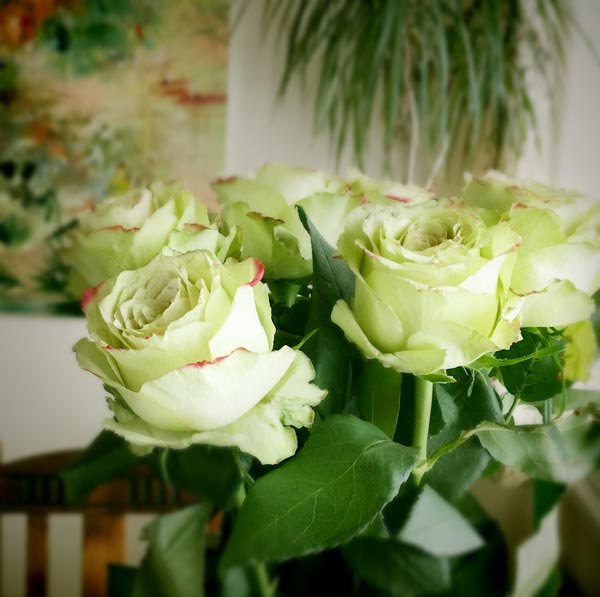
But green flowers can be enough. So, grand innovations can be replaced by many small tweaks.
Traditional or Not – Let’s Look at Jacob Marrel’s Flowers
Last week, I went to see old floral still lives at Sinebrychoff Art Museum. Still lives from the 17th century, like this one from Jacob Marrel, were my favorites. The subject is not creative: flowers in a glass vase, but small additions to a stereotypical interpretation make the painting stand out: butterflies and dragonflies, drops of water, red currants on the tabletop, black leaves that are easy to miss because they express the lighting so naturally, and the roses that sadly hang down, ready for withering.
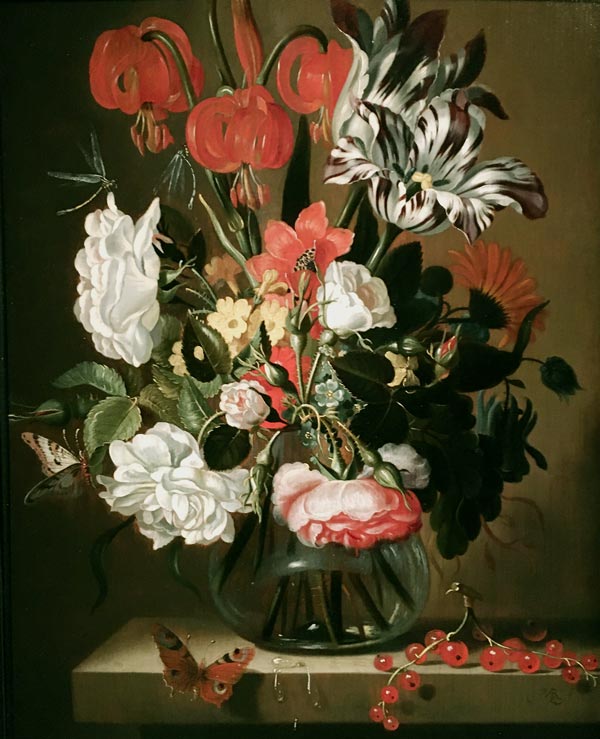
The best floral still lives from the 17th century are often Dutch, but Jacob Marrel (1613-1681) was German. He was a teacher, too, running a school for floral painters. I would love to turn back time and participate in his lessons! I would also have a question:
“Do you, Herr Marrel, think about the plant’s personality when you are painting it?”
Flowers Are Free Souls
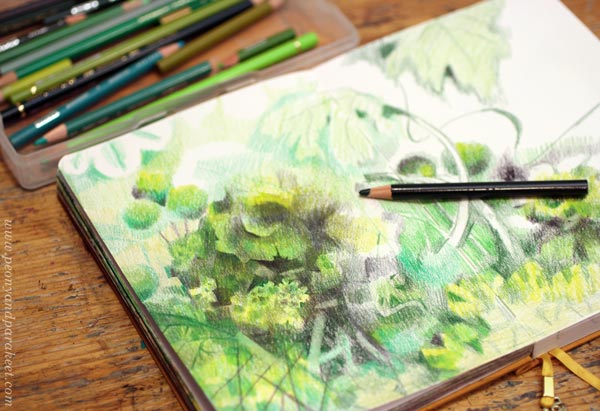
When I started this spread in my colored pencil journal, I felt that I just needed to let the flowers dance the way they wanted. So I didn’t sketch the big picture but worked little by little and endured the chaos, trusting that the flowers and leaves would find their natural gestures.
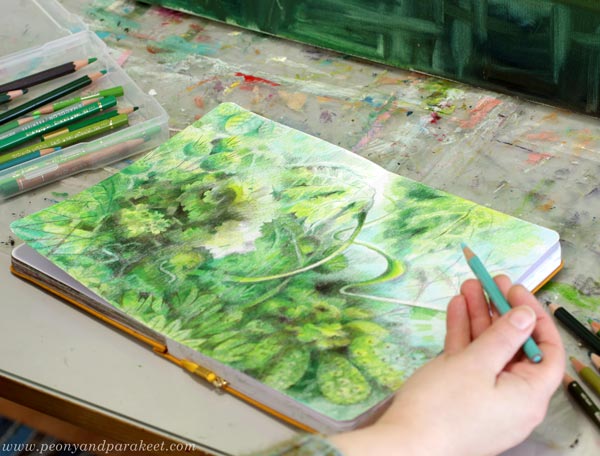
I want to let my art express itself as freely as possible.
How to Free the Flowers – 5 Tips
- Don’t make every flower similar, but let the diversity capture the viewer.
- Don’t differentiate flowers only with color but with shapes and lines too.
- Color a spot and ask what it wants, and allow green flowers – so, odd variations!
- Get inspired by the imperfection of reality! It’s natural to grow curvy, wither, have texture on the leaves, and get really dark or bright.
- Allow shapes and colors to breathe. You don’t have to know what every element in your drawing represents.
From Drawing to Painting
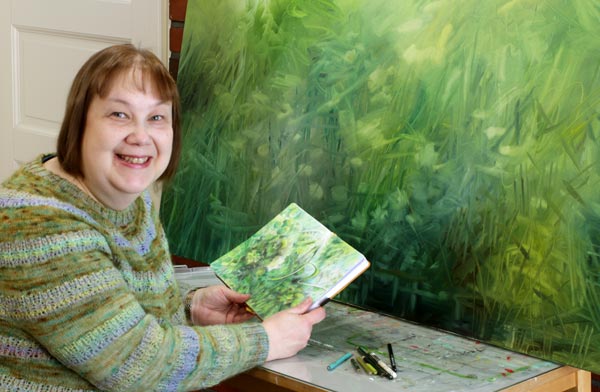
The first quarter of the year has been full of drawing and building the new class Fun Botanicum. But now a new series of paintings have started, and I have lots of big canvases to paint before the solo show in June. In the photo above, you see the first painting still in progress. My journal pages and my paintings live separate lives, but still, they inspire each other. It’s exciting to translate illustrative journal pages to more abstract paintings, and vice versa. I like this way of working a lot.
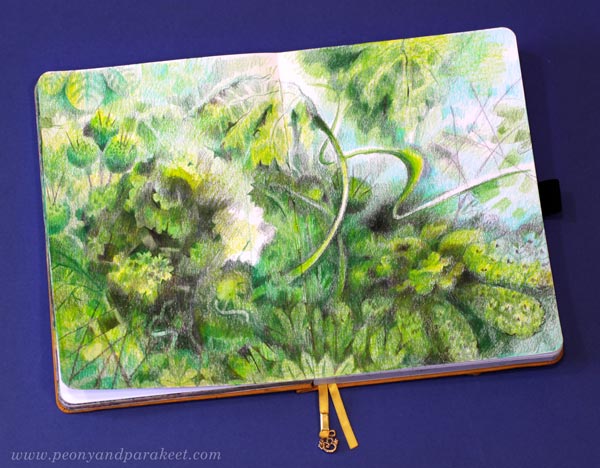
Now, when Fun Botanicum has started, I am also looking forward to seeing art from the participants: flowers, hays, fruits, berries, mushrooms … in all colors!
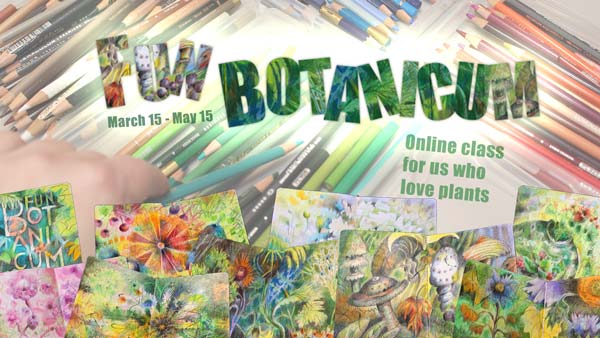
The new class Fun Botanicum has just started. You can still hop in and sign up!
5 Reasons Why I Love Colored Pencils
This week’s post is an affectionate thank you to my colored pencils.

Here’s why I love them so much!
#1 Colored Pencils Add Magic to Everyday Moments
Colored pencils are quick and easy for everyday use. Whenever I write, I can quickly pick a few pencils and color a part of the text or make a small illustration.
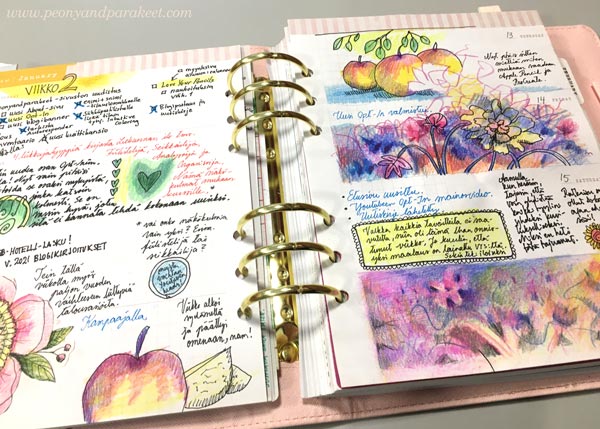
Planners, shopping lists, and any notes become more cheerful when I add some colored pencils to them.
#2 Colored Pencils Change a Journal to a Treasure
Colored pencils are perfect for small journals. When I started my colored pencil diary last year, I wasn’t sure how long the inspiration would last. But the small size felt so easy that the pages kept coming, and I love to browse the journal often. It’s my inspiration book and one way I do “research” – search for ideas that reappear more freely in my paintings.
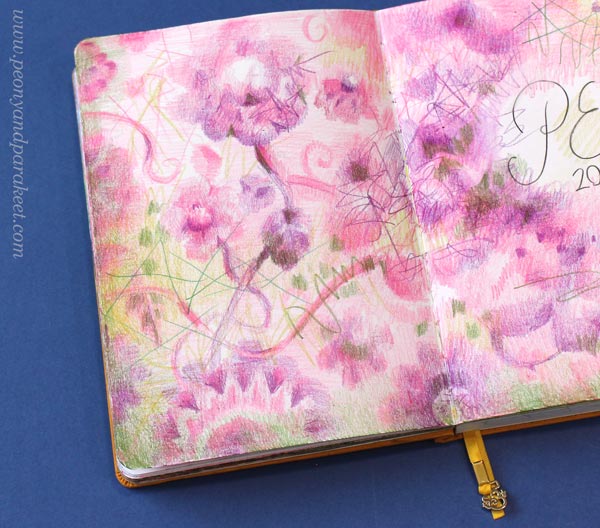
This spread is a part of a new class, Fun Botanicum, where we make a set of plant-inspired pages. The idea of making chapters and different types of pages in a journal is so inspiring. One small journal can be like a library that has many collections!
#3 It’s Enjoyable to Paint with Colored Pencils
After painting a series of oil paintings, I am usually exhausted. Then my pencils feel a refreshing approach to painting. When I “paint” with colored pencils, I press only lightly like holding a brush, make soft and blurry shapes, and create color mixes by layering. This way, I fly to my imagination without making a mess or worrying over things like drying time or fluency.
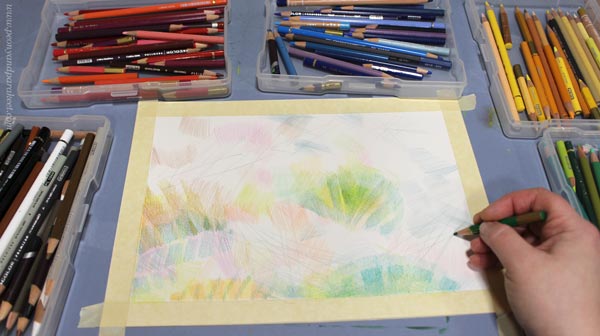
I feel a similar softness to using a brush when smooth hot press watercolor paper meets a wax-based pencil. Gentle strokes don’t hurt but nurture the hand, and the overall experience speaks self-love: “Be gentle, focus on the good in the world.”
#4 Colored Pencils Love Lines
I love drawing lines, and fortunately, my colored pencils love them too. I can draw straight lines, curves, continuous mesh, outline – all my pencils require is sharpening now and then!
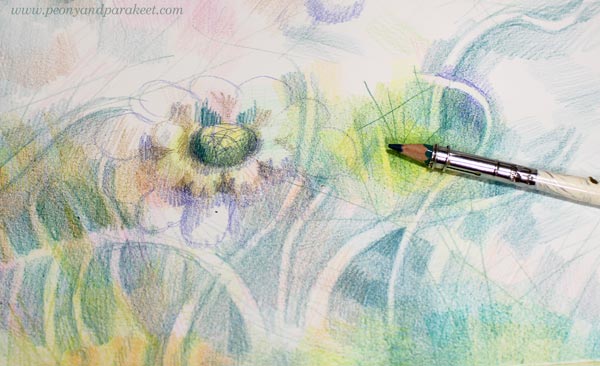
I love the willingness of my pencils to work until they are too short for the extender. I try to treat them as well as I can, no matter how short they are and what brand they represent. Old pencils can do lines too!
#5 Colored Pencils Can Take a Break
My oil paints are like afghan hounds. They require a lot of care and attention, and they always look appalled if I stop too soon. But colored pencils are like little parakeets. They sing when I am with them but are happy to fall asleep when nothing is happening. So I can color just a bit and then leave the project to wait for the next free moment. My pencils are ok with that – Every Single Time!
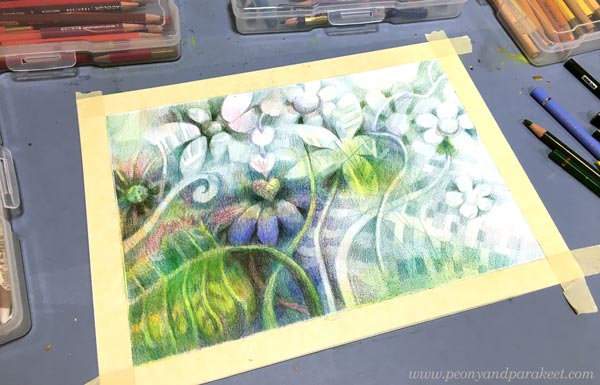
For example, this week’s work was made in several sessions. Watched the news and colored some. Listened to an audiobook, and colored some. Walked by and decided to color some. Unlike my oil paints, colored pencils never complain about what I listen, and they don’t get jealous if I watch tv at the same time.
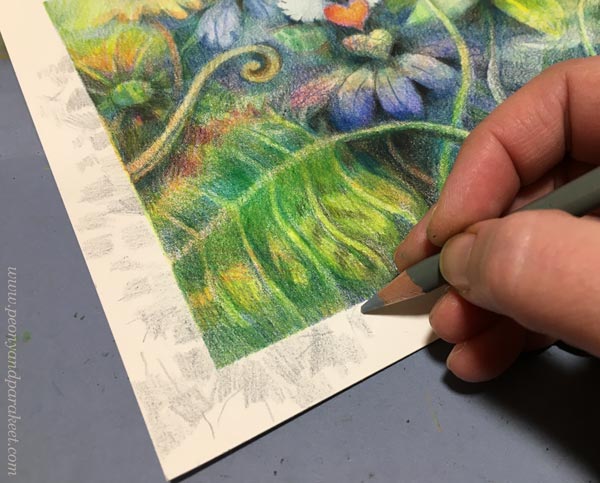
First, I didn’t intend to color the border, but then I couldn’t help myself to spend a little more time with the pencils.
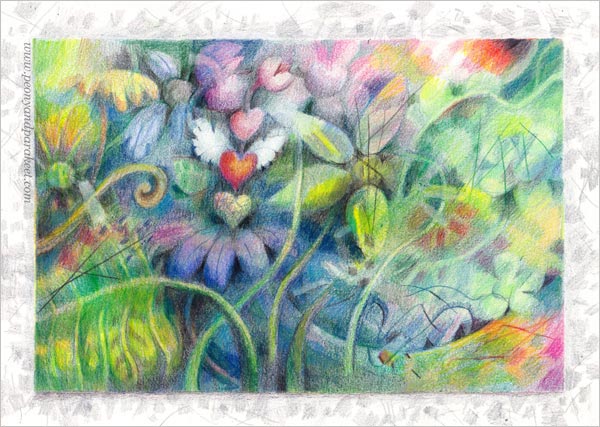
Hearts make this piece a bit cutesy, but colored pencils always make me more playful than paints.

I love this system of color-coordinated boxes!
Having Good Time with Fun Botanicum
Let’s gather colored pencils and get inspired by plants, crazy lines, delicious colors, and the freedom of imagination.

Fun Botanicum begins on March 15. Sign up now!
Layering Colored Pencils – Magical Effects Step by Step
This week, I have a new spread for my colored pencil journal, and it’s based on layering colored pencils. I share detailed photos so that you can try this too!
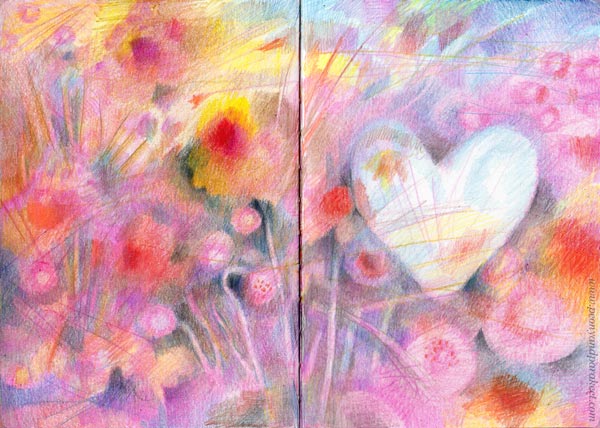
This coloring technique creates magical looseness, even if it begins with very stiff shapes. Because layering the colored pencils is the key here, it’s important to keep the layers light because paper can’t hold color endlessly.
Step 1 – Set Atmosphere
Choose a color that sets the mood for the image. My choice was pink.
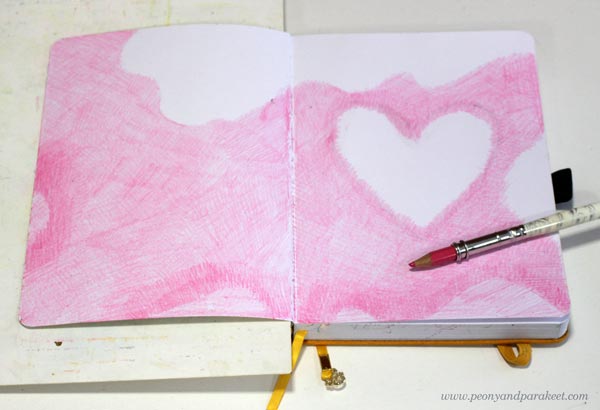
Color the background lightly, but leave some blank areas near the edges and where you want the focal point to be. The heart is my focal point.
The blank parts will allow you to include lovely color variations in the last layers. Color softly and avoid outlines so that the overall feel is magical from the first layer.
Step 2 – Add Pattern
Stick with the same pencil and continue the monotone look by coloring rings on the colored area.
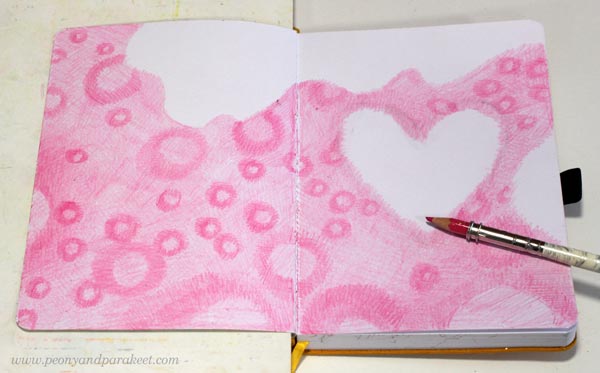
Make sure that the rings are different in size and spread a little unevenly so that the result looks natural and interesting. Think about fabrics but not the easiest polka dots, but a bit more intricate design.
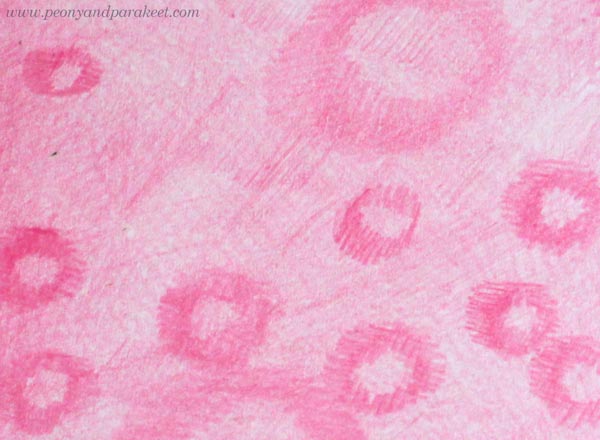
Here’s a closeup of my rings. Again, I don’t use outlines but color them with short strokes that go in many directions.
Step 3 – Destroy
This step could be called “destruction” because now we color random shapes that don’t follow the previous layers at all. Bring in new bright colors. Color stripes, rectangles, random shapes, and lines freely.
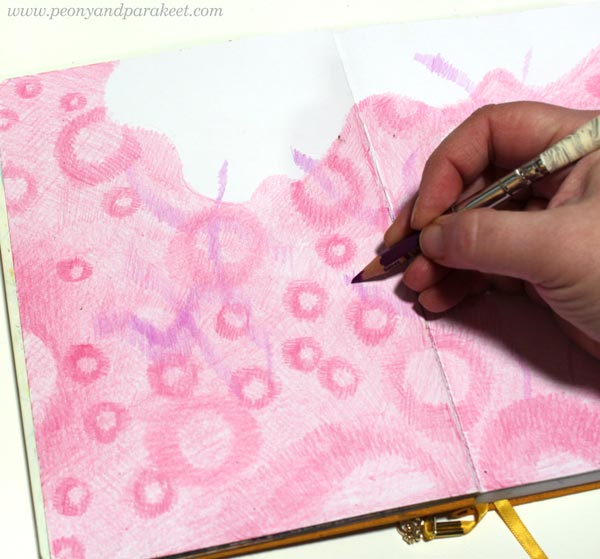
You can go over the blank parts too but keep the focal point a little less untouched.
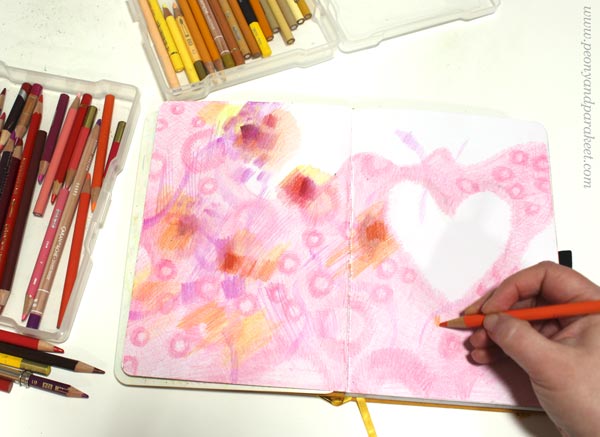
The idea is not to cover previous layers fully but to destroy their rhythm.
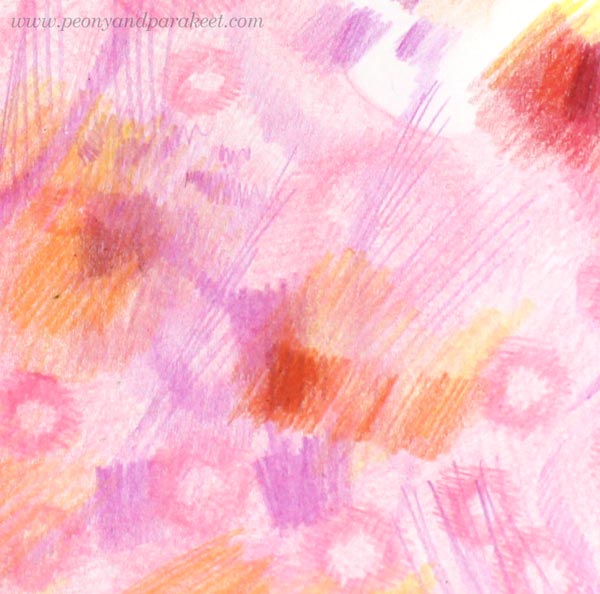
Here’s a closeup of my work. The new shapes and lines have taken over, and the rings are not so well visible anymore.
Step 4 – Discover
Keep coloring, but now bring in darker tones too. Keep the layers light and shapes soft, but when you discover something that you like, highlight its edges with a darker color.
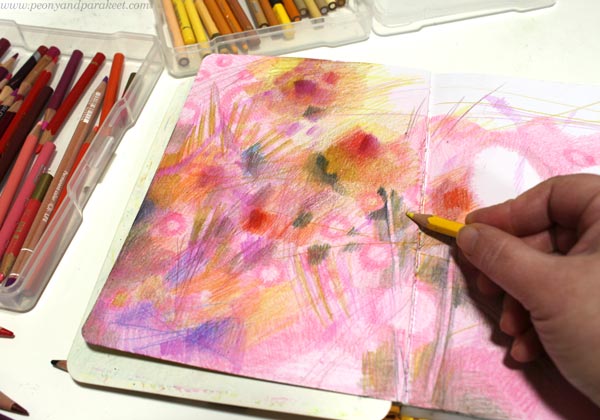
I didn’t use any green pencils in my spread, but it does have some green shades. Mixing black and yellow makes lovely olive green.
Now it’s also the time to bring some rings back to the foreground!
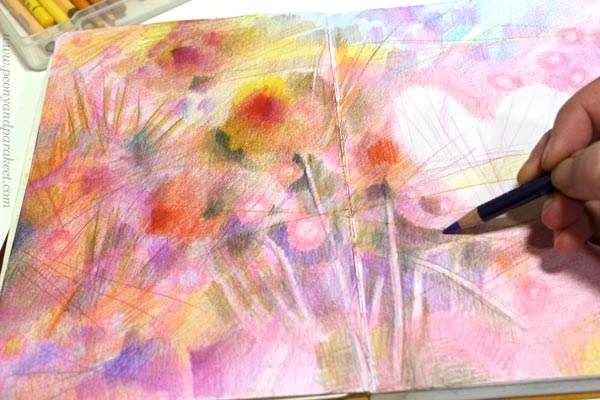
These rings remind me of perennial Bellis flowers!
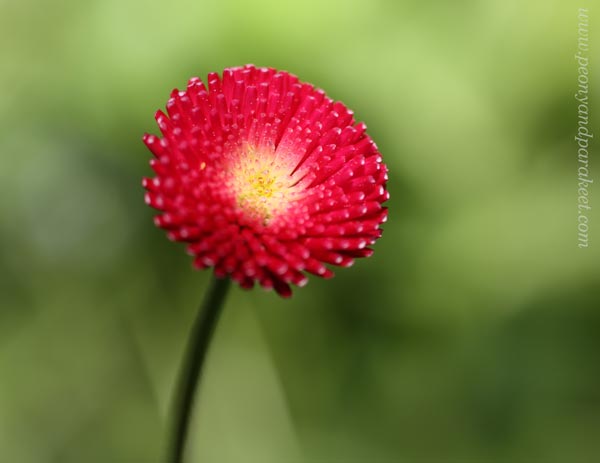
Here’s a closeup of digging out the rings – now flowers – with dark colors.
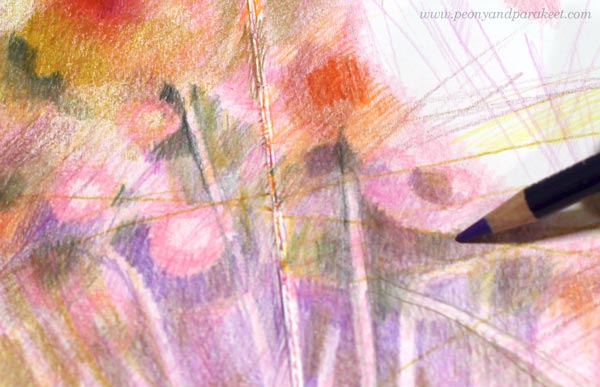
I don’t bring up all the rings, just some! This makes the layered look: some elements are covered and located further in the background, some come up to the foreground. The stiffness of the background pattern looks attractive when it’s combined with looser coloring.
Step 5 – Finish with Message
Your work will be finished when it delivers a message. The focal point, the heart in my case, is essential for achieving this. I like to work intuitively so that I don’t try to define the message right from the beginning but let the insight grow with the coloring. Here, I left the heart light and made it look icy and magical.
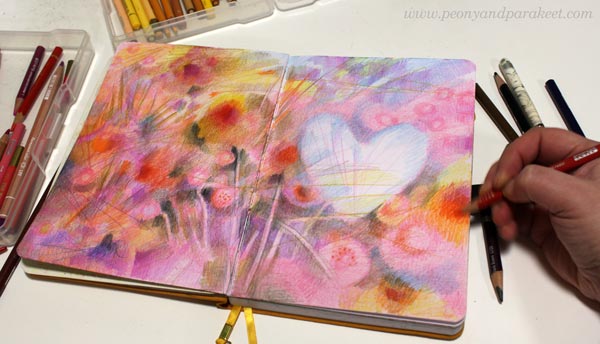
First, I thought about this winter, how tough it has been to walk the dogs on icy roads, and how much I want spring to come. And then it hit me how ice must mourn when its life is coming to an ending. How between the first flowers, there’s a little block of ice, looking around, feeling isolated.
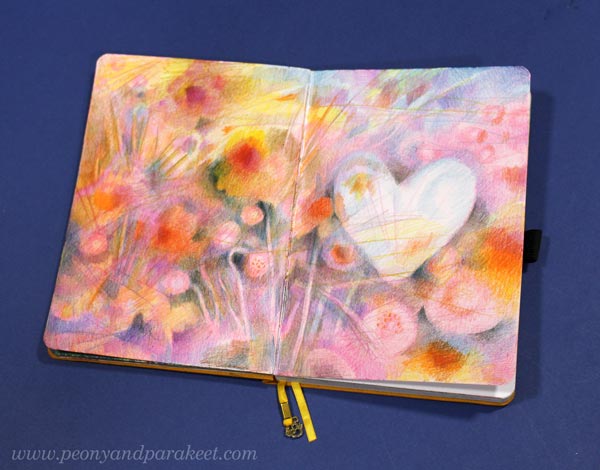
This little frozen heart is like a rare unicorn – reflecting the surroundings, introvertedly, like we all do when we are creating.
I find this kind of pondering an important part of art-making. That’s why I always try to end with a message even if viewers can freely find their explanations as well.
Fun Botanicum – Sign up Now!
From March 15 to May 15, 2022, I run an online class for us who are inspired by nature and fantasy and love plants. The class is called Fun Botanicum and we will draw fantasy plants by scribbling, doodling, and layering with colored pencils. Join us!
The early-bird sale ends soon! Early-bird price: 59 EUR, now 49 EUR. >> Sign Up Now!
The sale ends on Feb 20, 2022, at midnight PST.